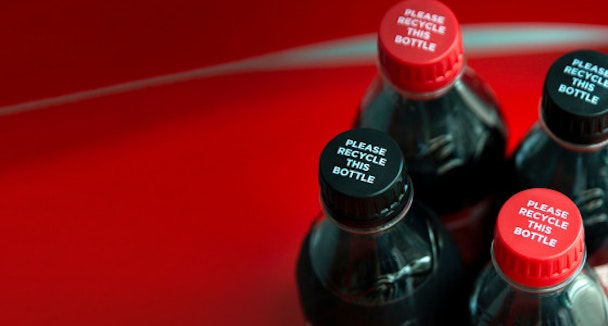‘Brand always comes first’: Coke’s design boss on selling recycling revolution
The Drum sits down with the soft drinks giant‘s global vice-president of design, Rapha Abreu, to discuss how it can transform its portfolio of brands without sacrificing its most iconic designs.

Coke recently introduced attached caps to tackle plastic waste / Coca-Cola
Coca-Cola, one of the world’s biggest plastic polluters, has ambitions to change for the better. Via its ‘World Without Waste’ strategy, the drinks giant aims to develop a circular economy through more sustainable design, effective waste collection and environmental partnerships.
But while packaging is usually the first thing to come to people’s minds when they think about sustainability at Coca-Cola, global vice-president of design Rapha Abreu explains that the manufacturer’s commitments also extend across water, climate and supply chain.
“On the packaging front, we have five main goals and two key milestones in 2025 and 2030. By 2025, all of our packaging will be recyclable – that includes all the components in everything we sell. [Abreu estimates this will account for approximately 3m metric tons.] By 2030, 50% of the materials used in our packaging will be recycled.”
Advertisement
Also by 2030, Coca-Cola will collect and recycle a bottle or can for each one it sells. This will be done primarily by improving waste collection by incentivizing consumers through deposit return schemes and packaging recovery partnerships across different countries.
It will also extend to its soft drinks dispensers, incorporating reusable cups to be served in restaurants and other public venues.
Abreu says that Coca-Cola is fortunate in many ways as the brand’s heritage status means consumers are already familiar with certain design components that are inherently better for the planet – such as Coke’s signature glass bottle.
“Of course, we were founded by mixing our product in a pharmacy and selling it in a glass bottle, but we weren’t thinking about sustainability back then.”
Advertisement
The plastic problem
As the provider of the most popular soda in the world, alongside a huge portfolio of 500 other brands, Coca-Cola is now present across 200 countries and territories worldwide and its intensive manufacturing has come at great expense to the planet. In 2022, the drinks manufacturer was named the world’s biggest plastic polluter for the fifth consecutive year in Break Free From Plastic’s annual audit.
But Abreu claims the reality is more complicated. Due to Coca-Cola’s global presence, its reliance on water across its value chains has become intertwined with its pledge to replenish 100% of the water it utilizes in the manufacturing process.
“There are countries in which we operate where we are the only ones supplying clean water for people to drink. Using plastic for transportation in those instances is much more efficient than glass bottles, which are smaller, heavier and prone to breaking.
“Sustainability is not a silver bullet, you see; there’s not one solution for everything.”
Instead of simply switching to cans (which Abreu explains are more easily recycled but require more energy to produce), Coca-Cola has invested heavily in replacing virgin plastic with plant-based, recyclable plastic, as well as with plastic harvested from ocean waste.
Suggested newsletters for you
While there is a balance to be struck between maintaining Coke’s iconic design and improving its circularity, Abreu says consumers are more forgiving than you might imagine.
On the recent change to Coke’s bottle tops where attached caps have been introduced in the UK to make the recycling process easier and reduce litter, Abreu says young people have been especially supportive of the move.
“They are OK with having a different experience because they see its value and are willing to compromise. This might have been a concern in the past, but not any more.”
He says Coke has encountered a similar reaction with trials of its recyclable plastic, which can appear cloudier than the virgin plastic bottles consumers may be familiar with. “There were concerns consumers would question the quality or purity of the product, but this hasn’t been the case.”
Communicating sustainability without compromising brand
The challenge remains to effectively communicate these changes to customers without resorting to cliched branding exercises. “We recently had a debate in the US after the team there created a label with ‘100% recycled’ in very bold lettering. We felt the message was taking over the brand.
“Sustainability is always the right thing for a company, so when you rely on it in marketing it reads overly promotional. But there is a delicate balance between over-communicating and making sustainability part of your visual identity.”
Abreu suggests one solution is finding clever ways to incorporate key elements of branding into sustainable reimaginings; for example, the ‘Georgia green’ color of Coca-Cola glass bottles was already synonymous with its color palette, he explains, “so that’s the green we use to communicate sustainability in our labels.”
“The brand should always be the first thing you see, then once you get closer, you realize there’s more information. By marrying the identity with the brand, you never fight or overshadow what the brand actually is.”
He says one of the key challenges Coca-Cola is now facing overall is communicating sustainability across its entire portfolio of brands. “We can’t just do this for Coke the brand; it has to include Sprite, Fanta, Smartwater and Powerade, because all the global brands we have are following the same commitments.”
Teasing new communication from the brand around how its commitments extend across the portfolio, Abreu shares the vision of “empty Fanta bottles becoming full bottles of Coke, the idea being that a Coke today can become a Sprite tomorrow.”
The Drum interviewed Rapha Abreu, global vice-president of design at Coca-Cola, in September at the Paradigms conference in Lisbon.

